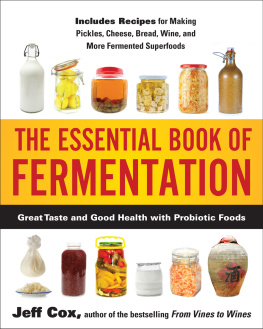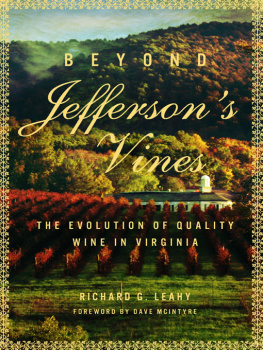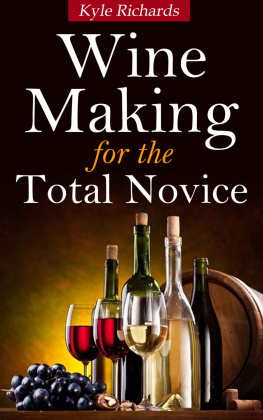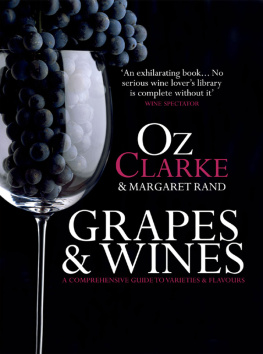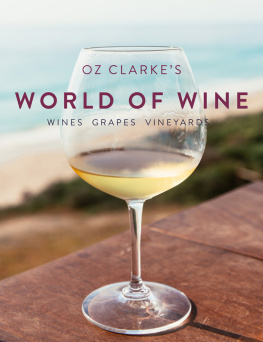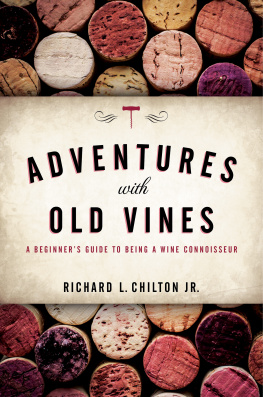From VINES to WINES
THE COMPLETE GUIDE TO GROWING GRAPES AND MAKING YOUR OWN WINE
Jeff Cox
Foreword by Tim Mondavi

The mission of Storey Publishing is to serve our customers by
publishing practical information that encourages
personal independence in harmony with the environment.
Edited by Julia Rubel and Nancy Ringer
Cover design by Cynthia McFarland
Cover photograph Philip Wallick, Jon Gnass Photo Images
Text design by Mark Tomasi
Production by Erin Lincourt
Line drawings by Alison Kolesar (based on original illustrations by the author), except pages 218 and 219, by the author
Indexed by Hagerty & Holloway
1999 by Jeff Cox
All rights reserved. No part of this book may be reproduced without written permission from the publisher, except by a reviewer who may quote brief passages or reproduce illustrations in a review with appropriate credits; nor may any part of this book be reproduced, stored in a retrieval system, or transmitted in any form or by any means electronic, mechanical, photocopying, recording, or other without written permission from the publisher.
The information in this book is true and complete to the best of our knowledge. All recommendations are made without guarantee on the part of the author or Storey Publishing. The author and publisher disclaim any liability in connection with the use of this information. For additional information please contact Storey Publishing, 210 MASS MoCA Way, North Adams, MA 01247.
Storey books are available for special premium and promotional uses and for customized editions. For further information, please call 1-800-793-9396.
Printed in the United States by Versa Press
30 29 28 27 26 25 24 23 22 21 20
Library of Congress Cataloging-in-Publication Data
Cox, Jeff, 1940
From vines to wines : the complete guide to growing grapes & making your
own wine / Jeff Cox. 3rd. ed.
p. cm.
Includes index.
ISBN 978-1-58017-105-2 (pbk. : alk. paper)
1. Viticulture. 2. Wine and wine making. 3. Viticulture United States. I. Title.
SB389.C69 1999
634.8 dc21
98-39860
CIP
DEDICATION
For Susanna

ACKNOWLEDGMENTS
The role of the author of a book like this one is to be a synthesizer and coordinator of knowledge most of it developed or discovered by other people. I would like to thank the following people personally:
Jack Hudders, for getting me interested in wine. Bob Teufel and Mike Michaelson, for fomenting that interest over the years. Tom Jacobsen and Tim White, who kindly offered to read the manuscript with their experts eyes.
Friends in the Napa Valley who took me in: Gary Wu of Beaulieu Vineyards; the Kresge family; Peter Forni; the Triglia family; Arnold Tudal; Theo Rosenbrand of Sterling Vineyards; Tobey of Wine & The People in Berkeley; Tom Cottrell and Bob Pool of the New York State Agricultural Experiment Station in Geneva; Dr. Konstantin Frank; all the folks at Sakonnet Vineyards in Rhode Island; and Dr. John McGrew of the USDA.
And most special thanks to Joe Swan, Randall Grahm, Darrell Corti, Tom Dehlinger, Forrest Tancer, and Bernard Portet, who have taught me so much about wine and winemaking.
J.C.
CONTENTS
TABLES
FOREWORD
I congratulate Jeff on this important book. Having a good understanding of the basics of wine gives rise to a better appreciation of those subtle nuances one discovers when enjoying it. There are myriad details and much hard work that ultimately unite to make wine the most delicious and pleasurable of beverages. From Vines to Wines helps provide you with the knowledge you need to become a winegrower in the best sense of the word.
I have always used the term winegrower rather than winemaker because it better expresses my belief that the personality of great wine is a manifestation of its terroir the distinct soil, climate, and people involved in the process. The love of wine is inextricably linked to a respect for the land and what it brings us. Wine is grown, and we meticulously cultivate our vineyards in order to ensure that eventually there is a clear sense of place in the glass. The terroir provides the character potential for the wine, the vintage provides a unique personality, and we then interpret those distinctions in our own style.
I have always been a great believer of research, so that we can continue to gain valuable insight into farming practices that help us produce wines of concentration, elegance, and rich varietal character. For example, we have learned volumes from preserving our old vines, many of which are still producing exceptional wines of great depth and complexity. We have learned that high-density planting produces richer, more flavorful wines. We carefully match clones and rootstocks to specific soils and climates. We know that gentle handling throughout the entire process is vitally important. Finally, our belief in sustainable farming affects everything we do as we are committed to being stewards of the land so that it remains rich and healthy for many generations to come.
The intrigue of wine is unlimited. As a winegrower, I have the great pleasure to observe the varied moods of a single wine in its lifetime on the vine, in the fermenter, during its aging in barrel and in bottle, and in a glass throughout the course of a meal. With frequent tastings, we can see through these changes in the wines mood (as well as our own) and understand its exciting potential.
This is the joy of wine. May it continue to bring grace to your table and zest to your life.
TIM MONDAVI, Winegrower
Robert Mondavi Winery
INTRODUCTION
Fresh grapes and wine are perhaps the most luscious foods we mortals encounter during our sojourn here. Thats a big part of the unique affinity between grapevines and humankind. Thats how the vine has tempted us to take it down from the wild trees, to protect it and work with it, so we can have its fruit at will.
The vine repays our care with lavish benefits. For three days after drinking a bottle of 1969 Chambertin, the sun and blood of Burgundy drenched my aura. The memory of the taste lingered.
Vines splurge on flavor in those very climates that are most hospitable to humans northern California and southern France, for two outstanding examples. They seem to be luring us, coaxing us to stay and care for them, suggesting how good life can be in those places.
Not every climate ripens the most flavorful grape varieties so slowly and perfectly. But every place has its potential: in the colder regions east of Paris the vignerons take their high-acid, low-sugar underripe grapes and transfer them into Champagne. In Austria, where hard freezes hit clusters still hanging on the vine, they make Eiswein.
In the United States, weve hardly begun to explore our viticultural potential. Who knows what vinous treasures could flow from the south-facing shale and slate hills of eastern Pennsylvania or the fertile, stony soils of the Ozarks? Our Lafites and Romane-Contis is undiscovered beneath forests and fences. Or, possibly, theyre waiting for us in our backyards.
In wine-growing areas you see the vines stretched on their trellises, their arms wide open in welcome, or, in a different light, resembling rows of the crucified. In winter, there are the bones: black and dead-looking trunks waiting to be reborn in new green flesh. The new growth creates the grapes, develops them over a summer and finishes its work with sugar and perfume. The ripe grapes can be transformed into wine (a totally transcendent change that couldnt be predicted from knowledge of grape juice alone), but only with the intervention of man or woman to perform the practical rituals of winemaking. Wine is truly a collaboration of vine and human, and the consummation of their affinity.



